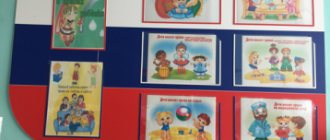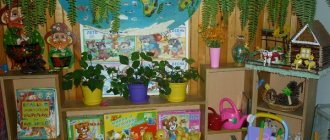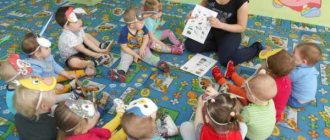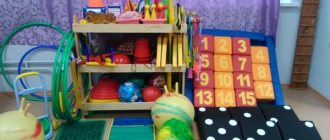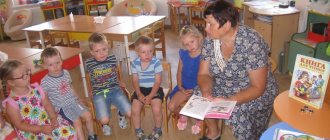An important part of the subject-development environment in the group room is the book corner. This thematic “center of the book” can play a significant role in shaping children’s sustained interest in books, the desire to read, and the need to learn new things.
In the publications presented in this section, teachers share their positive experience of creating beautiful, well-designed and functional book corners, and give useful advice on the aesthetic design of this part of the group’s subject-development environment.
Make the book corner the pride of your group!
Contained in sections:
- Book. All materials on the topic of books 6894
- Corners and centers in groups 6116
Showing publications 1-10 of 255. All sections | Book corner, center. Design examples
New
Photo
The best
Consultation for parents “How to organize a book corner in the family” A children’s book is a means of mental, moral and aesthetic education. Children's poet I. Tokmakova called children's literature the fundamental basis of education. Fiction shapes moral feelings and assessments, norms of moral behavior, educates...
Organization of a book corner in the first junior mixed age group
Reading fiction plays an important role in the development of children's cognitive and creative abilities. The main task of introducing preschool children to fiction is to cultivate interest and love for books, the desire to communicate with it, the ability...
Book corner, center. Design examples - Our book corner. Photo report
Publication “Our book corner...”
A book corner is a necessary element of a developing subject environment in a group room of a preschool institution. This is a form of disseminating information about books, their authors and illustrators, helping children get used to the image of a book, arousing interest in it, desire...
Image library "MAAM-pictures"
Book corner in early childhood group
In the Rainbow early childhood group, we have created a book corner in which children can independently choose books and calmly look at them. The book corner turned out to be cozy and attractive. It is located away from where children play, so that noisy games do not distract the child, good…
Basic requirements for the design of book corners
Fiction reveals to the child the main secret of life - he is not alone in this world: what worries him, cared for his ancestors, worries his contemporaries, will care for his children and grandchildren. A book corner is a necessary element of a developing subject environment in a group...
Group book corner
“Book corner of the “Romashka” group” V. Sukhomlinsky said: “Reading in childhood is primarily the education of the heart, the touch of human nobility to the innermost corners of a child’s soul.” Preschool childhood is a very important stage in raising an attentive, sensitive reader...
Guidelines for maintaining a book corner in a preschool institution
Book corner
- a necessary element of the developmental subject environment in the group room of a preschool institution. Its presence is mandatory in all age groups, and the content depends on the age of the children. The book corner should be located so that anyone, even the smallest child, can reach out and take the book he likes without outside help exactly when he himself wants to do it. A variety of books should be displayed in the book corner: new, beautiful, well-read but neat. The corner should not be a ceremonial corner, but a working one. Its purpose is not to be a bright, festive decoration for a group room, but to enable a child to communicate with a book. Used books are sometimes more attractive to the reader simply because it seems to him that a frequently read book should be interesting.
Main goals
book corner are:
- development of children's cognitive and creative abilities through children's fiction;
- the use of innovative educational programs, methods and technologies for the education and development of children in accordance with their psychophysiological characteristics;
- creating psychologically comfortable conditions in accordance with the age and individual characteristics of children in the group;
- ensuring productive interaction with parents in solving the problems of raising and developing children
In the book corners of those group rooms where there are young children, there should be as many toy books as possible. The older the children, the more serious and voluminous the books are located in the book corner. The number of books should not be regulated. It depends on the tasks that the teacher sets in working with children during the day or week. If a teacher introduces children to the work of one author and has at his disposal 2-3 books by a writer or poet, he should display them and not chase the quantity. By changing the subject of conversation with children, we change books. If the teacher is talking about the genre of fairy tales, you can display 5 - 7 books of fairy tales, interesting, diverse, high-quality both from the point of view of illustration and from the point of view of printing.
The frequency of book exchange also depends on the specific goals of introducing children to reading. The composition of the book corner may not change for a week or even two when both the teacher and the children constantly need to access it. But, if a change of books has occurred, the children need to point this out or ask them to notice it, give them the opportunity to look at new books, ask the children what stopped their attention, what book they wanted to read right away. In the book corner you can place portraits of writers and children's book illustrators. Book exhibitions should be dedicated to the work of individual writers, individual genres (fairy tale, humorous story, encyclopedia, etc.) and even one book, for example, one where a work illustrated by different artists is published. Older children will not only enjoy looking at the masterpieces of book art, but will also definitely notice the differences in the creative style of the artists and choose the book that will be closer to their aesthetic taste, their ideas about the heroes and characters of the work.
Children are jealous of the books they bring from home. They want the teacher to read these books, show them to all the children, look at them with everyone, and read them. In this regard, you can arrange an exhibition of books that children will bring from home for a short period of time. But in order not to exhibit all 15 - 20 copies, it is immediately necessary to establish and strictly observe the order in which not only the books will be exhibited, but also the owners, the children, will talk about them, what they like about them, for what purpose they brought the books to a preschool. Knowing the children, you need to try to formulate questions for the kids in such a way that their stories turn out to be detailed and interesting.
Another thematic exhibition may be dedicated to a specific work, which is not only read to children, but also illustrated by them. In this case, you can go in two ways: exhibit the work and the best drawings for it, or place all the drawings one by one on the exhibition stand. Both need to be motivated. Children must understand the teacher’s choice so as not to be offended and stop reading and drawing. (see table)
In addition to books, the book corner may contain a variety of albums for viewing. These can be albums specially created by artists on certain topics (“Different Animals” by N. Charushin, “Our Children” by A. Pakhomov, etc.), albums compiled by the teacher from individual postcards and drawings about work, nature in different seasons, about professions, etc. In older groups, thematic exhibitions of books can be organized in the book corner. Their main goal is to deepen the literary interests of children, to make one or another literary or socially important topic particularly significant and relevant for preschoolers.
Things to remember:
- A book corner in a preschool institution is not only a necessary element of the subject environment. This is a form of disseminating information about books, their authors and illustrators, helping children get used to the image of a book, arousing interest in it, a desire to look at and read it.
- A thoughtful, regular exchange of books in the book corner should not be an obligation, but a rule for the teacher.
Principles for selecting literary works for children
Fiction
– one of the most important means of comprehensive development of the personality of a preschooler. The content of a work of art broadens a child’s horizons, takes him beyond personal observations, opens up social reality to him: it tells about the work and life of people, about great deeds and exploits, about events from the world of children’s games, fun, etc. The artistic word creates the true beauty of the language, emotionally colors the work, sharpens feelings and thoughts, influences, excites and educates.
The correct selection of literary works, which is based on the following pedagogical principles, helps open the world of “verbal art” to children:
- Literature must meet the tasks of educating (mental, aesthetic, moral) children, otherwise it loses its pedagogical value. The book is intended to reveal to preschoolers in concrete images the ideals of goodness, justice, courage, and to form the correct attitude towards people, oneself, and one’s actions;
- it is necessary to take into account the age characteristics of children. Age specificity should be expressed in taking into account the characteristics of the child’s psyche, concrete thinking, impressionability, vulnerability;
- the book should be entertaining. Entertaining is determined not by the topic, not by the novelty of the material, but by the discovery of something new in the familiar and something familiar in the new;
- The book must clearly express the author's position. (S. Ya. Marshak wrote that if the author is not an indifferent recorder of events, but a supporter of some heroes of the story and an enemy of others, this means that the book is written in real children's language);
- books should be lightweight in composition, i.e. have one storyline. An artistic image or system of images must reveal one thought, all the actions of the characters must be subordinated to the transmission of this thought. However, when selecting books, one should not give preference only to small and simple works. It must be taken into account that children’s perception capabilities are growing.
The selection principles make it possible to determine the range of children's reading, which includes:
- works of folklore (songs, nursery rhymes, proverbs, sayings, fables, shifters, fairy tales);
- works of Russian and foreign classics (A.S. Pushkin, K.D. Ushinsky, N.A. Nekrasov, L.N. Tolstoy, F.I. Tyutchev, G.H. Andersen, C. Perrault, etc.);
- works of modern domestic literature (V.V. Mayakovsky, S.Ya. Marshak, K.I. Chukovsky, S.V. Mikhalkov, M.M. Prishvin, E.I. Charushin, V.V. Bianki, E. Blaginina , Z. Alexandrova, etc.).
- works of different genres (stories, tales, poems, fairy tales in prose and verse, lyrical and comic poems, riddles), different subjects (children's life: games, fun, toys, pranks; events of social life, people's work; pictures of nature, environmental problems );
- works of peoples of other countries.
Every year new books for children are published. Educators should monitor published literature and replenish children's reading range.
The main task of teachers is to instill in children a love of the literary word, respect for the book, and the development of the desire to communicate with it, i.e., everything that forms the foundation for raising a future “talented reader.”
Organization of a book corner in groups of primary preschool age
| Filling the corner | Pedagogical work with children | Rules of conduct in the corner of the book |
| As a rule, only 4-5 books are exhibited. Two or three copies of identical books may be presented. They place publications that are already familiar to children, with bright, large illustrations. Individual pictures, illustrations. Small albums for viewing on topics close to this age: “Toys”, “Children’s games and activities”, “Pets”, etc. Particular preference for picture books. Book illustrations should follow the text step by step, revealing to the child in detail the artistic world of the work. Baby books, toy books, etc. can be presented. | The teacher teaches:
Repeated communication with a book allows a child not only to become more deeply aware of its content, but also to experience the creative joy that an encounter with art brings. | In the younger group, the teacher gives the first lessons in independent communication with a book:
In the middle group, these skills are consolidated and become a habit. Children are shown how to care for a book and are invited to observe and participate in the repair of books. |
Illustrations on various topics:
| Examination, familiarization with various objects and phenomena, work on vocabulary, grammatical structure, and coherent speech. In the junior and middle groups - 2-3 illustrations. |
Organization of a book corner in groups of senior preschool age.
The content is determined by changes in the literary development of children that occur by the age of 5. The book becomes an important part of the spiritual life of children; they develop literary preferences and expressed individual preferences.
The principle of the organization is to satisfy the diverse interests of children.
| Filling the corner | Pedagogical work with children | Work with children |
| Fiction You can place 10-12 different books at the same time:
| Pedagogical guidance is becoming more correct, because Children are already quite independent in choosing books.
|
|
| On average, the shelf life of a book in a book corner is 2-2.5 weeks. However, the basic rule must be observed: the book remains in the corner as long as the children remain interested in it. That's why some books stay long enough and others don't. Illustrations to various topics:
and other books on the program. | Introduces the world of nature, its secrets and patterns. Looking at a recently read book gives the child the opportunity to relive what he read and deepen his initial experiences. Repeated viewing satisfies children's need to have fun, laugh, and creates an atmosphere of emotional comfort. “Thick” books are read for a long time. Examination, familiarization with various objects and phenomena, work on vocabulary, grammatical structure, and coherent speech. | Pedagogical expediency. Taking into account the age characteristics of children. Design aesthetic. In the senior and preparatory groups there are 3-4 topics: 2-3 are devoted to phenomena of social life, 1 - to nature. |
| Albums for viewing specially created by artists, albums on various topics (“Different animals” by N. Charushin, etc.) Albums compiled by the teacher together with the children (postcards, drawings, illustrations) | Examination, familiarization with various objects and phenomena, work on vocabulary, grammatical structure, and coherent speech. |
|
| Children's magazines In the preparatory group, space is allocated for periodicals (children's magazines “Funny Pictures”, “Svirelka”, etc.) | Reading, looking at, working with plot pictures. | |
| Library In the preparatory group, a small library is created (preferably small books) | Let's introduce you to the library. Reading books and looking at illustrations. Speech communication, nurturing interest in books and reading, fiction, culture of behavior. | Drawing up a card index |
